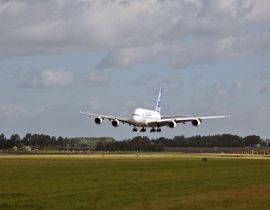 Air Traffic Control Netherlands (LVNL) has introduced a new technique that makes the latest flight information available to air traffic controllers. NLR developed and tested the prototypes and established the standards that the new system must meet.
Air Traffic Control Netherlands (LVNL) has introduced a new technique that makes the latest flight information available to air traffic controllers. NLR developed and tested the prototypes and established the standards that the new system must meet.
Thanks to this new technique (Mode-S Enhanced Surveillance), air traffic controllers receive an early warning if an aircraft could deviate from the assigned altitude.
Warning
This technique provides air traffic controllers with extra information that comes directly from the aircraft systems. When an aircraft, with a certain altitude set in its onboard computer, deviates from the assigned altitude, air traffic controllers receive a warning. This allows the controller to prepare for taking early action, in order to ensure the pre-assigned vertical and horizontal distances (separation standard) between aircraft is maintained.
In addition to the set altitude, the magnetic heading the aircraft follows and the air speed as seen by the pilot are displayed on the air traffic controller’s monitor. This means the air traffic controller can less frequently request this information from the pilot. This reduces the amount of radio traffic required, as well as the workload.
Prototypes
NLR made three prototypes in which the relevant aircraft information, Pilot Selected Level (PSL), Magnetic Heading (HDG) and Indicated Air Speed (IAS) were integrated in the LVNL air traffic controllers’ user’ interface. This information supports the air traffic controller in controlling air traffic efficiently and safely. The prototypes were tested in the NLR’s NARSIM flight simulator with air traffic controllers from approach- and area control.
For the final version of the Mode-S Enhanced Surveillance, NLR then established the standards the new system must meet. NLR also contributed to the test specifications.
Mode-S Enhanced Surveillance is now introduced for the air traffic that falls under the responsibility of the Area Control Centre’s general air traffic control, which is where the civilian air traffic in Dutch air space is controlled to a height of 24,500 feet. In 2013, the technique will also be introduced for Approach, the approach air traffic control for Amsterdam Airport Schiphol. Approach controls flights destined for Schiphol, as well as air traffic departing from this airport.
LVNL introduced Mode-S Enhanced Surveillance in collaboration with it partners in the Knowledge & Development Centre Mainport Schiphol: the Ministry of Infrastructure and the Environment, KLM, Amsterdam Airport Schiphol and NLR.


